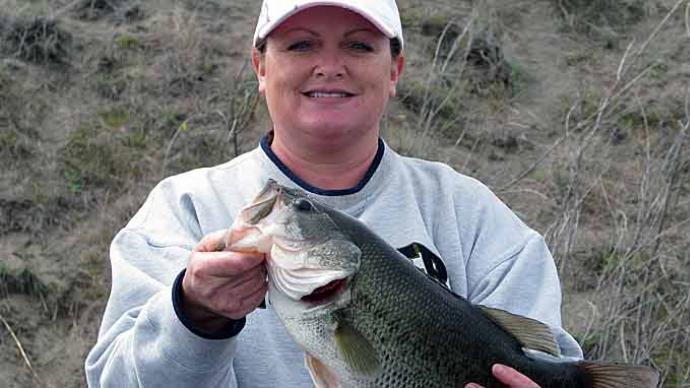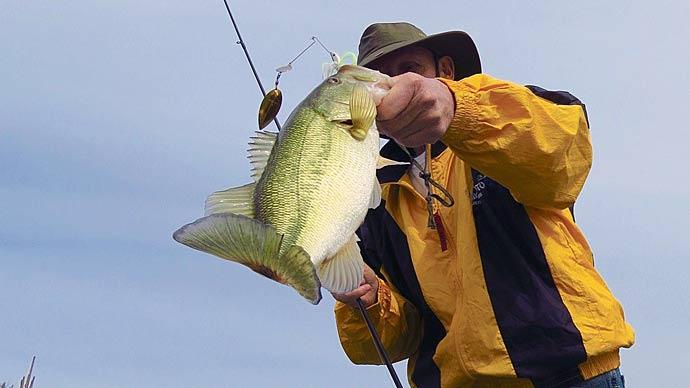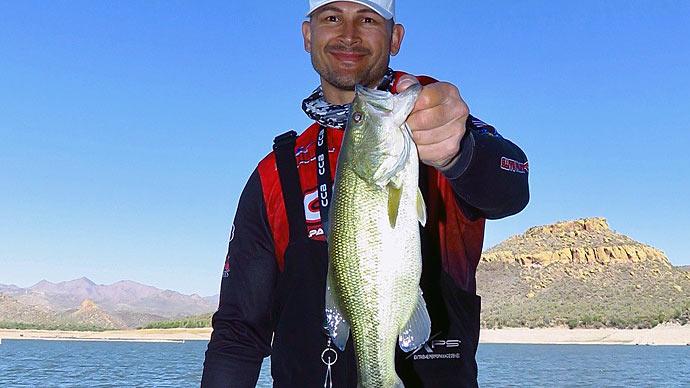
When spring arrives, lures start piling up in the storage compartment of my bass boat.
I usually only throw a handful of baits throughout the winter, including jerkbaits, Alabama rigs, and a casting jig or a football jig. However, when bass become more aggressive in the spring, I load the boat with a wide range of hard and soft plastic lures to catch bass from prespawn to postspawn.
Here’s a look at my five favorite lures for catching springtime bass.
Crankbait
After a long winter of seeing slow-moving lures, bass get into a chasing mode when the water temperatures start to climb. So when the water temperature climbs above 45 degrees, I start throwing crawfish-colored Storm Lures Wiggle Wart, and Spro RkCrawler crankbaits to rocky banks. Crawfish-colored crankbaits work best during this time because the mudbugs are getting active, and bass are looking for a different meal than the shad they have been eating all winter.
During a two-day tournament this March, my partner and I caught most of our fish on crawfish-colored crankbaits and finished fourth in the event with ten bass weighing 37.80 pounds. On both days, we targeted main and secondary points where the fish were either close to the bank or out in depths of 6 to 8 feet. The key to our retrieves was keeping our lures moving at a steady pace and occasionally twitching our rods to imitate a fleeing crawfish.
Spinnerbait
During the same tournament, I caught one of our 4-pounders on a 1/2-ounce white spinnerbait. The blade bait usually comes into play for me when the water temperature climbs into the upper 40-degree range when I employ a slow-roll retrieve, so the lure barely ticks the rocky bottom. As the water temperature continues to climb, I will speed up my retrieve so the spinnerbait will ride higher in the water column.
The spinnerbait produces best for me in dirty water and on windy days. My favorite spinnerbait for slow-rolling in the early spring is a 1/2-ounce model with a single gold or silver Colorado blade, which produces plenty of flash and vibration for bass to detect in the dirty water. Later in the spring, before the bass move on beds, I switch to a 3/8-ounce spinnerbait with tandem willowleaf blades to make my blade bait ride higher in the water.
Jig

I fish a jig year-round, and the lure is probably the best big bass bait for me in the spring. The beauty of this lure is I can fish it effectively in shallow water with a lighter finesse-style jig, or I can probe the 10- to 12-foot depths with a heavier jig to catch bigger female bass waiting for their time to move to the bank.
Another advantage of the jig is that I can work it in three different ways depending on the fish's mood. During cold fronts, I can present the jigs to any available cover and let it sit for a couple of seconds before trying another target. When bass are holding tight to the bottom, I can drag the jig along and hop it a few times to tempt these fish into biting. I can swim the jig close to the bottom for the most aggressive bass, occasionally letting it tick the bottom and then lifting it again.
Stickworm
Yamamoto Senkos or Yum Dingers are my top choices for a wacky rig when I sight fish for bass on nests or cruising fish in the shallows.
For nesting bass, I try to throw past the nest to keep from spooking the fish and slowly pull the lure back to the bedding fish. I want the lure to come in from behind the fish, so I can let it swim over the top of the bass and fall right in front of its nose. If the bass fails to inhale it, I let it sit in front of the bass and shake the stickworm a couple of times to get the fish’s attention. After letting it sit in the nest for 5 to 10 seconds without getting a bite, I will reel in the bait and throw it past the nesting fish again to repeat the process.
For cruising bass, I try to lead the fish by casting about 3 or 4 feet in front of the fish and then twitching the stickworm until it reaches the cruiser's path. When the bass gets close to the lure, I stop twitching the bait and let it fall to the bottom, which usually produces a strike.
Walking Topwater
A Heddon Zara Spook is my all-time favorite topwater plug to throw during the spawn and postspawn.
Walking a Zara Spook is deadly for both bass on beds and cruising bass during the spawn. I also like throwing it along the sides of the docks where the bigger female bass are suspended under the dock foam.
During the postspawn, I throw the Spook along secondary and main lake points where the recuperating bass have relocated after leaving the spawning banks. Whenever I see a bass following the lure, I speed up my retrieve, which imitates a baitfish trying to escape from the pursuer and triggers a strike from the following bass.
BassResource may receive a portion of revenues if you make a purchase using a link above.




